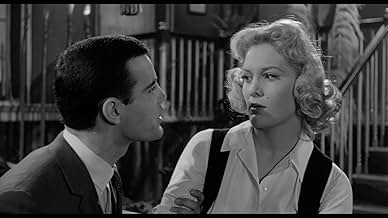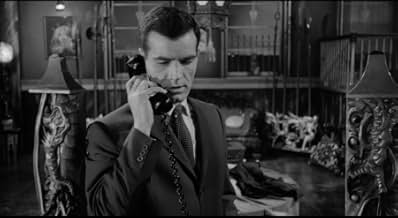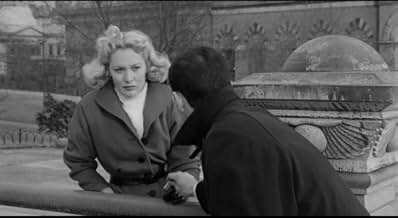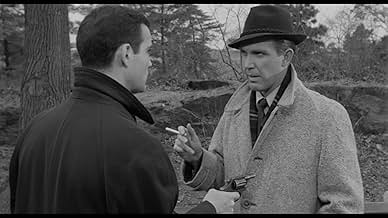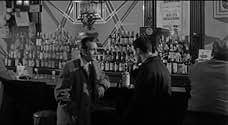Aggiungi una trama nella tua linguaA detective investigating the murder of a heroin addict discovers that there is a connection between the junkie and his fiancee, who is his boss' daughter.A detective investigating the murder of a heroin addict discovers that there is a connection between the junkie and his fiancee, who is his boss' daughter.A detective investigating the murder of a heroin addict discovers that there is a connection between the junkie and his fiancee, who is his boss' daughter.
- Regia
- Sceneggiatura
- Star
Recensioni in evidenza
United Artists dumped this lousy movie, understandably since it lacks any entertainment value. As the title suggests, there was exploitation movie material to be mined here, but one-shot movie director Gene Milford (whose day job was film editing) delivered a deadly dull stinker with a no-name cast.
Writing credits are strictly A-list: screenplay by Harold Robbins early in his career, from an Ed McBain novel by Evan Hunter. But they have no feel for the genre. It plays like a reject episode of TV's "Naked City" series, with on-location photography plus chintzy studio interiors.
Cops are played by Robert Lansing and John Astin, also having career off-days. Heroine (who is hooked on perhaps heroin?) Kathy Carlyle is good looking but an instant flop -her only other movie was a routine Charles Bronson war picture.
The title character played by Felice Orlandi is a bore -instantly one-note evil. Addiction then and now is a surefire formula for drama, but Robbins, unlike his future amazing success with so many hit novels like "The Carpetbaggers", comes up with nothing but dullness.
Writing credits are strictly A-list: screenplay by Harold Robbins early in his career, from an Ed McBain novel by Evan Hunter. But they have no feel for the genre. It plays like a reject episode of TV's "Naked City" series, with on-location photography plus chintzy studio interiors.
Cops are played by Robert Lansing and John Astin, also having career off-days. Heroine (who is hooked on perhaps heroin?) Kathy Carlyle is good looking but an instant flop -her only other movie was a routine Charles Bronson war picture.
The title character played by Felice Orlandi is a bore -instantly one-note evil. Addiction then and now is a surefire formula for drama, but Robbins, unlike his future amazing success with so many hit novels like "The Carpetbaggers", comes up with nothing but dullness.
God damn the Pusher man. He's got the snazziest digs, wears the sharpest threads, snags the hottest dames, and makes it all look easy. As played by natty hipster Felice Orlandi (Renick in BULLITT), he's like a Bizarro World Hugh Hefner, albeit with a pocketful of smack. This guy is the personification of quiet cool -- that is, until he becomes the object of vengeance by a junkie's unrelenting father, who just happens to be a police lieutenant.
Based on an Ed McBain 87th Precinct novel, THE PUSHER is less a police procedural than a sleazy, heavy-breathing crime meller, which should come as no surprise since Harold Robbins wrote the screenplay.
Personally I wouldn't have it any other way.
Thanks to Robbins' unerring bad taste, the movie is lurid, lowdown fun, chock full of runny noses, twitchy mannerisms, overwrought withdrawals, and all manner of salacious misdoings. Unfortunately, thanks to first-time helmer Gene Milford, it also boasts the dullest, dreariest direction this side of an Edward L. Cahn opus. Hey, life''s full of trade-offs.
On the plus side, the film boasts evocative location photography by ace Big Apple d.p. Arthur Ornitz, a nifty score by renaissance music man Raymond Scott and attention-grabbing performances by Orlandi, Robert Lansing (as 87th Precinct regular Steve Carella) and Sara Amman, a five-alarm Latin hottie who performs a grind-till-you--lose-your-mind specialty dance that's worth the price of admission alone.
Based on an Ed McBain 87th Precinct novel, THE PUSHER is less a police procedural than a sleazy, heavy-breathing crime meller, which should come as no surprise since Harold Robbins wrote the screenplay.
Personally I wouldn't have it any other way.
Thanks to Robbins' unerring bad taste, the movie is lurid, lowdown fun, chock full of runny noses, twitchy mannerisms, overwrought withdrawals, and all manner of salacious misdoings. Unfortunately, thanks to first-time helmer Gene Milford, it also boasts the dullest, dreariest direction this side of an Edward L. Cahn opus. Hey, life''s full of trade-offs.
On the plus side, the film boasts evocative location photography by ace Big Apple d.p. Arthur Ornitz, a nifty score by renaissance music man Raymond Scott and attention-grabbing performances by Orlandi, Robert Lansing (as 87th Precinct regular Steve Carella) and Sara Amman, a five-alarm Latin hottie who performs a grind-till-you--lose-your-mind specialty dance that's worth the price of admission alone.
Gene Milford did not build a household name, even in the realm of B productions like THE PUSHER . I have not seen anything else done by him, but THE PUSHER deserves above average rating.
One curiosity is that 1958 is the year that appears in the opening credits, but IMDB makes it 1960. Was in production for two years? It looks so shoestring that I doubt it, to be honest.
Albeit offering a generally realistic view of New York between those years, the film opens by introducing you to Lt Byrne, his wife, his daughter Laura, and the latter's boyfriend, Steve, also a copper. All, law abiding, all likable... but you discover very rapidly that Laura begins to stray, taking drugs on the quiet. She knows what she is doing, the dangers involved, the impact on her father and boyfriend, and she is convinced she can kick the habit but she just keeps diving deeper into it, getting her stuff from "Ganzo", another name for the pusher, who is very credibly played by prim and proper looking Felice Orlandi.
Of course, moral and family issues rise to the surface, and Lt Byrhe becomes extremely interested in the case when he gets what is happening with Laura and helps her with cold turkey treatment.
It makes you think that by 1958/1960 drug trafficking still seemed a minor and relatively containable problem, and yet since then even the finest police force in the world, US Police, has not managed to reduce it significantly, let alone stop it. And with new drugs being engineered full time, like crack, ecstasy, fentanyl, and all the rest of it, the common citizen has become more and more a target for the panoply of pushers, sellers, and others keeping that infamous trade ticking.
Sadly, by the time this well-meaning, honest film wrapped up, I could only think that mankind heeds no warning, however clear, and in the long run it is condemning itself to extinction for the sake of enriching drug lords.
Strong B noir photography by Arthur Ornitz, credible screenplay by Evan Hunter. 7/10.
One curiosity is that 1958 is the year that appears in the opening credits, but IMDB makes it 1960. Was in production for two years? It looks so shoestring that I doubt it, to be honest.
Albeit offering a generally realistic view of New York between those years, the film opens by introducing you to Lt Byrne, his wife, his daughter Laura, and the latter's boyfriend, Steve, also a copper. All, law abiding, all likable... but you discover very rapidly that Laura begins to stray, taking drugs on the quiet. She knows what she is doing, the dangers involved, the impact on her father and boyfriend, and she is convinced she can kick the habit but she just keeps diving deeper into it, getting her stuff from "Ganzo", another name for the pusher, who is very credibly played by prim and proper looking Felice Orlandi.
Of course, moral and family issues rise to the surface, and Lt Byrhe becomes extremely interested in the case when he gets what is happening with Laura and helps her with cold turkey treatment.
It makes you think that by 1958/1960 drug trafficking still seemed a minor and relatively containable problem, and yet since then even the finest police force in the world, US Police, has not managed to reduce it significantly, let alone stop it. And with new drugs being engineered full time, like crack, ecstasy, fentanyl, and all the rest of it, the common citizen has become more and more a target for the panoply of pushers, sellers, and others keeping that infamous trade ticking.
Sadly, by the time this well-meaning, honest film wrapped up, I could only think that mankind heeds no warning, however clear, and in the long run it is condemning itself to extinction for the sake of enriching drug lords.
Strong B noir photography by Arthur Ornitz, credible screenplay by Evan Hunter. 7/10.
B-movies are sometimes envisaged as an inferior kind of films. No, it means that the production costs are not as elevated as A-movies. If a star actor gets, say, 1 million dollars for a movie, well, some films (without stars) were made with an overall expenditure of less than 1 million. Now, I don't really care about production's costs, and some B-movies are better than the more high-class ones (not this one, I must say).
The strong positive values of "The Pusher", in my opinion, are the well-defined plot, without any confusing sub-plots or blurred images and shots that let you quite uncertain about what has really happened, and the consequent linear execution of it. This is also a detrimental point, because when you reach minute 16th (of the overall 82), you will know exactly how will the narrative develop.
No thrills, consequently, but if you are a lover of the genre you will enjoy this film. I rated it 6; let's say, more precisely, 6 and a half.
The strong positive values of "The Pusher", in my opinion, are the well-defined plot, without any confusing sub-plots or blurred images and shots that let you quite uncertain about what has really happened, and the consequent linear execution of it. This is also a detrimental point, because when you reach minute 16th (of the overall 82), you will know exactly how will the narrative develop.
No thrills, consequently, but if you are a lover of the genre you will enjoy this film. I rated it 6; let's say, more precisely, 6 and a half.
I had never heard of this movie before, and I'm glad I checked it out. As a native New Yorker, I love seeing the location shots from the early 60's around East Harlem, Central Park and other places. Some changes since then, but some things are the same.
The same can be said for the theme of the movie, the sad reality of drug addiction. Some things never change, though opioids are now the fashion, rather than main lining heroine. Either way, it's just as pathetic.
Both Steve Lansing and Douglas Rogers do good acting jobs as police officers who go after the pusher that's supplying young people, including Laura (Kathy Carlyle), the daughter of one and fiancée of the other.
Ms. Carlyle gives a powerful performance as she goes through the stages of withdrawal, you really feel her suffering, as she's desperate for another fix of what she started taking as "headache medicine", or so she was told.
Felice Orlando is another good actor, as the evil but charming pusher, and Sara Ammon is also very good as Maria, the nightclub dancer/junkie who falls under his spell and helps cause her kid brother's death.
There are some exciting scenes involving Lansing and Rogers, who go after Orlando, risking their lives more than once.
As so often happens, there are familiar faces from TV: John Astin (in his first film role, pre "Addams Family') and David Ford, who fans of "Dark Shadows" will recognize as Sam Evans.
Worth watching.
The same can be said for the theme of the movie, the sad reality of drug addiction. Some things never change, though opioids are now the fashion, rather than main lining heroine. Either way, it's just as pathetic.
Both Steve Lansing and Douglas Rogers do good acting jobs as police officers who go after the pusher that's supplying young people, including Laura (Kathy Carlyle), the daughter of one and fiancée of the other.
Ms. Carlyle gives a powerful performance as she goes through the stages of withdrawal, you really feel her suffering, as she's desperate for another fix of what she started taking as "headache medicine", or so she was told.
Felice Orlando is another good actor, as the evil but charming pusher, and Sara Ammon is also very good as Maria, the nightclub dancer/junkie who falls under his spell and helps cause her kid brother's death.
There are some exciting scenes involving Lansing and Rogers, who go after Orlando, risking their lives more than once.
As so often happens, there are familiar faces from TV: John Astin (in his first film role, pre "Addams Family') and David Ford, who fans of "Dark Shadows" will recognize as Sam Evans.
Worth watching.
Lo sapevi?
- QuizFilm debut of John Astin.
- ConnessioniFeatured in Frightful Movie: The Pusher (1968)
I più visti
Accedi per valutare e creare un elenco di titoli salvati per ottenere consigli personalizzati
Dettagli
- Data di uscita
- Paese di origine
- Sito ufficiale
- Lingua
- Celebre anche come
- Narkotika
- Luoghi delle riprese
- 113 East 115 Street, New York, New York, Stati Uniti(Location where Anibal Hernandez's Body was found by Police)
- Azienda produttrice
- Vedi altri crediti dell’azienda su IMDbPro
Botteghino
- Lordo Stati Uniti e Canada
- 1656 USD
- Fine settimana di apertura Stati Uniti e Canada
- 1656 USD
- 9 mag 1999
- Lordo in tutto il mondo
- 1656 USD
- Tempo di esecuzione1 ora 21 minuti
- Colore
- Mix di suoni
- Proporzioni
- 1.37 : 1
Contribuisci a questa pagina
Suggerisci una modifica o aggiungi i contenuti mancanti

